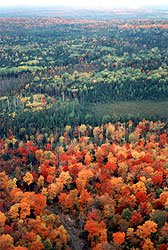Home → Kids' Page → General Tree & Forest Facts
 General
Tree & Forest Facts
General
Tree & Forest Facts
Did You Know?
- Each American uses the equivalent of one, 100-foot tree a year.
- The average single-family home (200sq. ft.) can contain 15,824 board feet of wood.
- Vigorously growing trees convert carbon dioxide and water into oxygen and cellulose, the building blocks of wood.
- In Maine, we harvest about 6.9 million cords of wood each year to build homes, make furniture, paper, and other products. Replanting of trees is rarely necessary as Maine’s forests reseed themselves naturally with an abundance of trees.
- To grow a pound of wood, a tree uses 1.47 pounds of carbon dioxide and gives off 1.07 pounds of oxygen. An acre of trees might grow 4,000 pounds of wood in a year, using 5,880 pounds of carbon dioxide and giving off 4,280 pounds of oxygen in the process.
- Of the 76 tree species in Maine’s forests, only 20 or so are used commercially for paper, lumber, and other products. These include: Spruce, fir and hemlock for structural lumber and –with some hardwoods – paper production. Eastern white pine for interior (finish) wood. Cedar for its weathering qualities. And Hardwoods, such as maple, birch, and oak for flooring furniture, and dozens of specialty wood products, such as dowels and tool handles.
Paper, Recycling & Environmental Impacts
- Every ton of paper recycled saves 3.3 cubic yards of landfill space.
- Paper can be recycled 4 to 5 times before the fibers lose their strength and wash out. New fibers added to the old can lengthen this recycling process.
- The forest also helps protect us from the effects of air and water pollution. Put simply, the surface and ground waters that flow out of the forest are less contaminated with man-made chemicals than the rain and snow that fall on the forest.
- Each year, paper is used to publish more than 2 billion books, 350 million magazines, and 24 billion newspapers in the Untied States.
- Trees are a renewable resource. Forest products are also recyclable and biodegradable.
- The Maine forest – with its vegetations, streams, lakes, wetlands, and groundwater aquifers – functions like a huge sponge that collects, cleans, and stores water. The forest’s water system is the foundation for wildlife habitats and recreational uses of the forest. It evens out lake levels, flows of streams and rivers, and groundwater levels, throughout wet and dry periods. And it provides Maine people with their drinking and household water.
- Over half the raw waste material used for paper comes from recovered paper and from wood wastes left by lumber manufacturing.
Sources:
The Maine Forest, Maine Forest Service Fact Sheet, April 2000
Forest Trees of Maine, Department of Conservation’s Maine Forest Service, 1995
The Forests of Maine, University of Maine’s Water Resources Program, May 1994